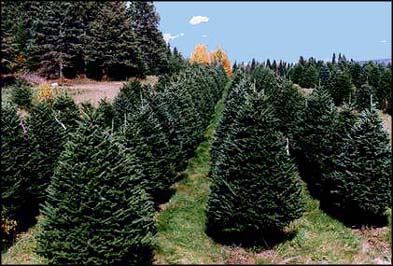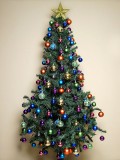Real Christmas Trees - Selection, Care, & Safety

Whenever I see a real Christmas tree, I'm reminded of the classic Christmas episode of Green Acres. Sam Drucker was selling artificial trees that squirted out spruce juice and came with artificial pine needles. He stated that they were "guaranteed to clog up your vacuum just as good as the real thing." Well, if you prefer to go ahead and get the real thing like Oliver Wendell Douglas did, read on.
Selecting and Caring for Your Christmas Tree
A lot of work and preparation occurs on the Christmas tree farm before a tree is ready to be shipped out to brighten the holidays. However, after the tree has left the farm, it must still be cared for on the retail and consumer levels as well.
Over the years, misinformation about the care and handling of cut Christmas trees has resulted in wasted trees, reduced tree quality, and poor tree care. Also, the recent trend of setting trees up earlier during the holiday season has increased the chances that the trees will not meet the quality and appearance expectations of the buyer during the display period if the trees have not received proper care.
1) Local vs. Imported Trees
Research has shown that trees shipped into markets from some of the major Christmas tree production areas generally arrive with as high a moisture level as fresh-cut trees grown locally. Generally, the handling of trees on the retail lots has at greater effect on their freshness and quality.
2) Species
Certain varieties will stay fresh and last longer than others. Some of the best are the North Carolina Fraser fir, Douglas fir, Balsam fir, and Scotch pine. Regardless of the species, the buyer must make the final judgment of quality by looking at, smelling, feeling, and shaking the tree.
3) Determining the Freshness of a Tree
Needles on fresh fir trees break crisply when bent sharply with the fingers. Trees that have lost a significant amount of moisture are more pliable and tend to bend without breaking. Because of their fibrous nature, needles on fresh pines do not break, unless they are very dry.
4) Cutting the Trunk
Cutting a thin layer (1/4 to 1/2 inch) off the trunk before placing the tree in a water holding stand is all that is needed. It is recommended to make a new cut before putting the tree into the stand.
5) Split Trunks
If the tree has a split trunk, the ability of the tree to consume water should not be hampered if a fresh cut is made on the base. The durability of the tree will not likely be affected either.
6) Water
Generally, a tree can use up to a quart of water per day for each inch of stem diameter. The warmer the temperature and the lower the humidity where the tree is displayed, the greater the amount of water required by the tree.
Christmas Tree Safety
- Place your tree away from fireplaces, radiators, television sets, and other heat sources. These elements can prematurely dry out your tree.
- Make sure the tree has plenty of water.
- Never use lighted candles on your tree.
- Check all electric lights and connections before decorating the tree. Never use any lights with damaged cords.
- Do not overload electrical outlets
- Never go to bed or leave home with decorations still turned on.








